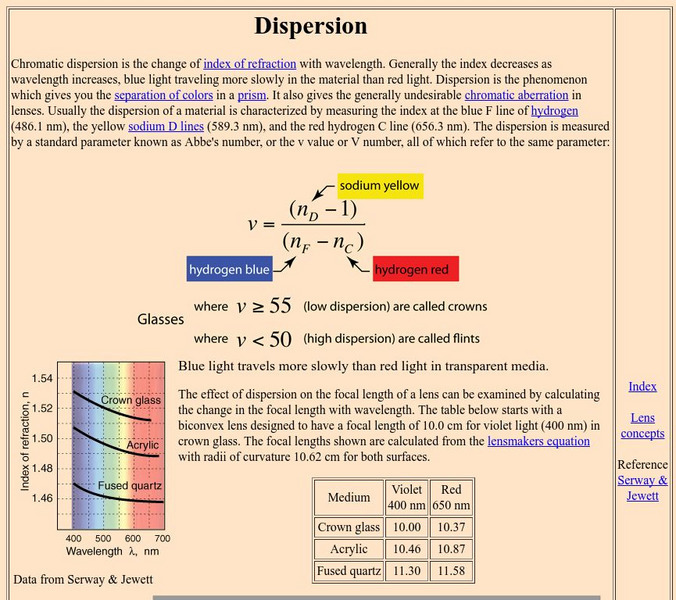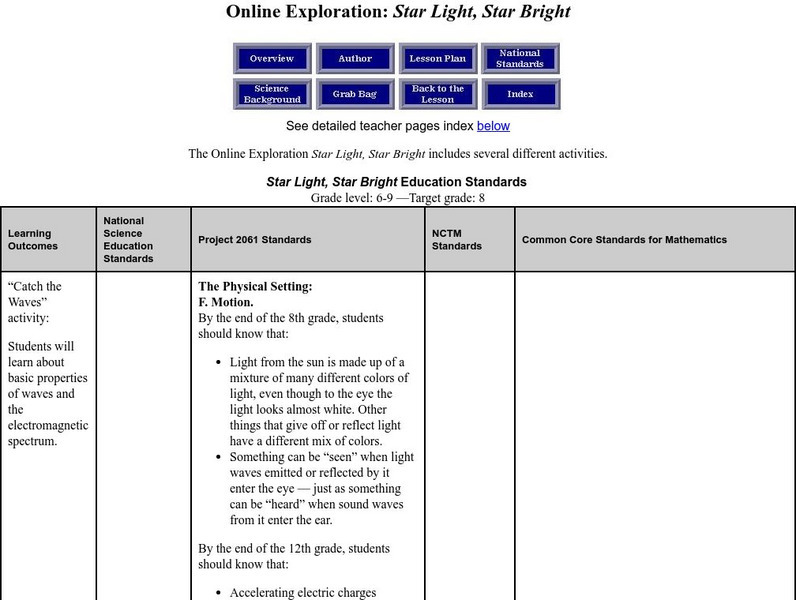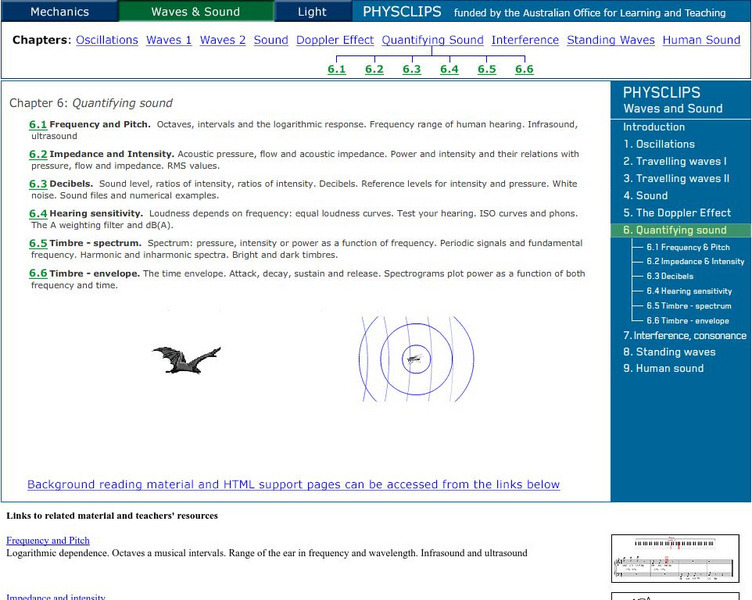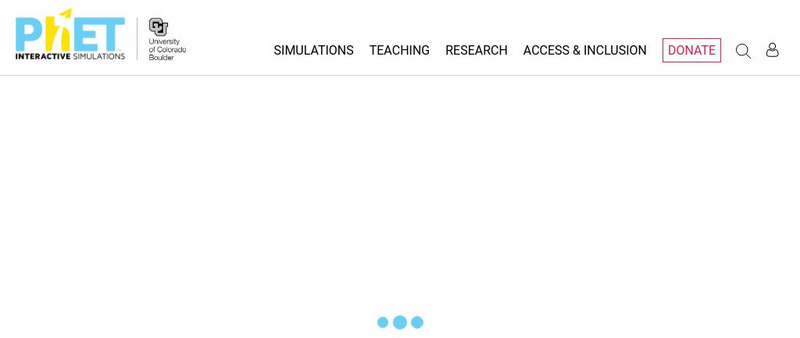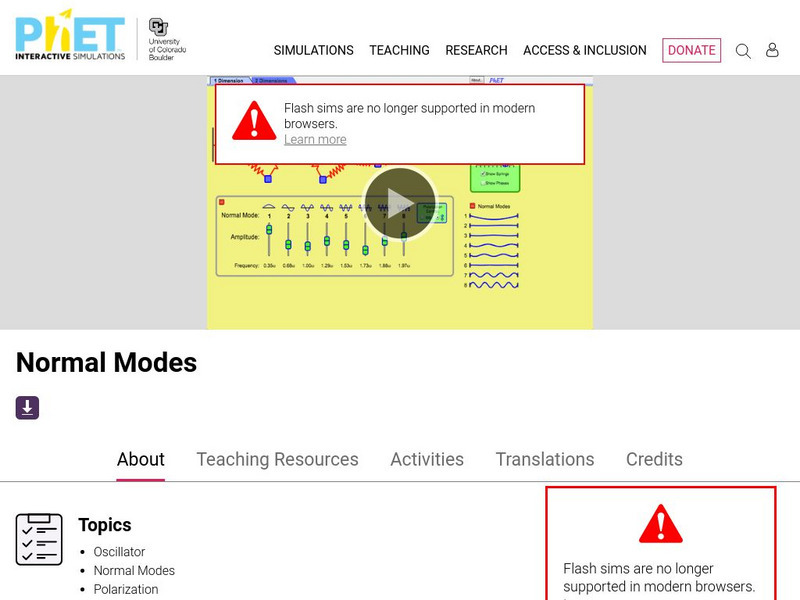ESL Kid Stuff
Time Frequency - "How Often ...?"
How often do you ride a bike? Time frequency words are featured in a lesson designed for ESL/ELD classrooms.
Mathematics Vision Project
Module 8: Modeling Data
Statistics come front and center in this unit all about analyzing discrete data. Real-world situations yield data sets that the class then uses to tease out connections and conclusions. Beginning with the basic histogram and...
PBS
Measuring Waves | UNC-TV Science
Discover the secrets used by scientists to measure mechanical waves. Young physicists learn about measurable wave qualities—amplitude, wavelength, and frequency—by watching and listening to a video discussing longitudinal and transverse...
PBS
Electromagnetic Spectrum | UNC-TV Science
Illuminate lightwaves, even those not visible to the human eye, in a concise activity about the electromagnetic spectrum. Pupils watch and listen to an animated video describing the electromagnetic spectrum as well as frequency and...
Mr. E. Science
Sound
Since light travels faster than sound, some people may appear bright until you hear them speak. The presentation covers what sound is, how fast it travels in various mediums, properties of sound, hearing, and the parts of the human...
Mr. E. Science
Characteristics of Waves
Waves, waves, and more waves. Here, class members look at the many types and characteristics of energy waves including transverse, longitudinal, standing, seismic, p-waves, s-waves, and l-waves.
National Council of Teachers of Mathematics
Seeing Music, Hearing Waves
In this music activity, 11th graders incorporate fractions into their music scales and counting scales. They listen to the music being played and relate it to sine waves reviewing the trig function. There are 11 questions involving sine...
Massachusetts Institute of Technology
Mit: Blossoms: Never the Way They Seem (Effect of Frequency)
An MIT mathematics teacher presents a module on a particular effect of frequency called the stroboscopic effect. Students will learn about low and high frequency phenomena, the stroboscope, and real-life examples of the stroboscopic....
Georgia State University
Georgia State University: Hyper Physics: Dispersion
The phenomenon of light dispersion is explained with a formula and a practice form for calculating Abbe's number.
Georgia State University
Georgia State University: Hyper Physics: Pitch = Frequency of Sound
Pitch is the ear's response to frequency, and here you can get a better understanding of pitch, its measurement and the perception of pitch.
PBS
Pbs Learning Media: Restocking Shoes
In this video from Cyberchase, Bianca uses data on past shoe sales to help her decide what quantities of each size she should order in the next shipment.
Space Telescope Science Institute
Amazing Space: Star Light, Star Bright
This online exploration provides an opportunity to identify the different properties of waves and the relationship that exists between energy, wavelength, and frequency. Correlate images from the Hubble Telescope to the wavelength,...
Science Buddies
Science Buddies: M&m Math
By using a simple bag of M&Ms, you can conduct an experiment in statistics to determine the frequency of colors in the package. The Science Buddies project ideas are set up consistently beginning with an abstract, objective, and...
Science Buddies
Science Buddies: Mp3 Squeeze: How Much Compression Is Too Much?
Do you love to listen to your MP3 player while you're exercising, or listen to songs on the Internet? The relatively recent development of MP3 technology has made it possible to take a stack of CD's and store them on a device no bigger...
University of Colorado
University of Colorado: Ph Et Interactive Simulations: Sound
This simulation lets you see sound waves. Adjust the frequency or volume and you can see and hear how the wave changes. Move the listener around and hear what she hears.
University of Colorado
University of Colorado: Physics 2000: More About Visualizing Electromagnetic Waves
Discusses the nature of an electromagnetic wave. Explains the oscillating electric field and represents it through clever graphics and animations.
Science Education Resource Center at Carleton College
Serc: Investigating Calculating the Effect of Mass, Length and Displacement
In this physics lab activity students investigate how mass, length and angular displacement affect the period of a simple pendulum. Students control variables, testing one variable at a time, using manual techniques (stopwatch, human...
University of New South Wales (Australia)
University of New South Wales: Introduction to Acoustics of Brass Instruments
Discover the acoustical properties of brass instruments from this well researched site provided by the University of New South Wales. Everything from lip control to bell shape is discussed as it applies to frequencies and harmonics.
University of New South Wales (Australia)
University of New South Wales: Introduction to Flute Acoustics
Explore the physics of sound production of a flute. How do things like tone holes and register holes effect the acoustics of a flute? Learn more about that and more at this well researched site.
University of New South Wales (Australia)
University of New South Wales: Introduction to Saxophone Acoustics
Learn all about the ways a saxophone produces sound. Discover why the reed, playing softly or loudly and tone holes play important roles in this instruments acoustics.
University of New South Wales (Australia)
University of New South Wales: Introduction to Clarinet Acoustics
Learn about how the acoustics of a clarinet work by exploring this well researched site. You'll learn about the frequencies, the effects of the reed, the tone holes and more.
University of New South Wales (Australia)
University of New South Wales: School of Physics: Physclips: Quantifying Sound
Learn about terms to quantify sound like pitch, frequency, decibels, and much more in this learning module. Learning module includes animations and videos.
University of Colorado
University of Colorado: Ph Et Interactive Simulations: Wave on a String
Explore the wonderful world of waves! Observe a string vibrate in slow motion. Wiggle the end of the string and make waves, or adjust the frequency and amplitude of an oscillator.
University of Colorado
University of Colorado: Ph Et Interactive Simulations: Normal Modes
An interactive simulation that teaches about oscillators, normal modes, and polarization by varying the number of masses and initial conditions to determine their effect on 1D or 2D systems of coupled mass-spring oscillators. This...








